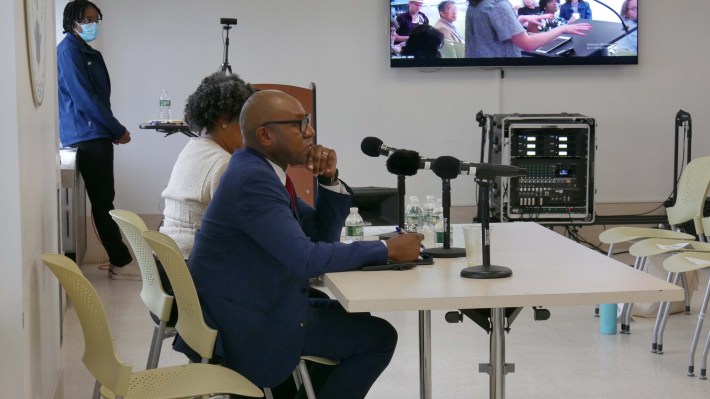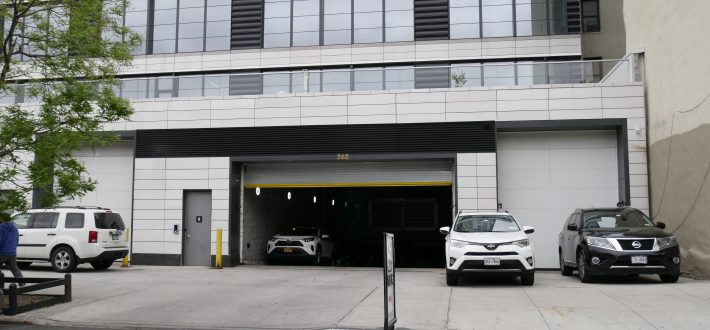He's parked the mayor into a corner.
The borough president of Queens says he's all in on creating more housing, but he won't support Mayor Adams's call to eliminate a requirement for developers to build costly parking citywide, claiming it would fail to create more housing in areas that have produced little under the current rules.
Borough President Donovan Richards approved the mayor’s City of Yes residential zoning proposal ahead of a key vote before the City Planning Commission, but rejected the mayor's bid to removing parking mandates in low-density areas of Queens, even ones with Long Island Rail Road stops, even though removing parking mandates does not eliminate the ability of a developer to build parking based on demand.

Parking mandates in "major transit hubs such as downtown Jamaica, Flushing, Long Island City and other similar locations" should be eliminated, Richard said, "in order to increase housing opportunities there."
"However," he added, "parking mandates should still be required in Outer Transit-Oriented Development Areas. The Long Island Rail Road serves OTODAs like Eastern and Southeastern Queens, but service is infrequent and many commuters must drive to LIRR stations."
Many of Long Island City's parking requirements were removed in 2011, and Jamaica is largely part of the transit zone established in 2016 under an earlier zoning change, meaning affordable housing developments are not subject to mandatory parking minimums.
In an interview with Streetsblog, Richards reiterated that he supports the mayor's effort to eliminate the parking requirement in high-density areas near subway stations, such as Jamaica.
“If you travel to the neighborhood," Richard said of the Eastern Queens neighborhoods where he lives, "you would know that even to get to the LIRR, you have to drive. If we had a better transit system, if we extended the subway system into the further reaches of Eastern Queens and Southern Queens, then I wouldn’t have an issue with [eliminating the] parking [mandate].”
Richards isn’t the only borough president to draw a hard line on parking. Bronx BP Vanessa Gibson also said “yes” to the mayor's re-zoning effort, but rejected removing parking mandates citywide. But housing advocates have consistently pointed out that the mayor's effort to incentivize development in low-density areas is built on removing mandates citywide.
"Many of the proposal elements are interrelated," said Marcel Negret, the director of land use at Regional Plan Association. "Transit-oriented development and 'town center zoning' are largely dependent on whether you have parking requirements or not because in these low-density neighborhoods the parcels tend to be smaller. If you still have [mandates], you are not extending the ability to a significant amount of parcels to take advantage of the new rules."
Richards’s claim that mandates should be removed in high-density neighborhoods yet maintained in lower-density areas highlights the very housing issue that the mayor hopes to fix with his City of Yes plan. The city's low-density neighborhoods have contributed only 9 percent of new housing units since 2010, according to a Citizen Housing and Planning Council report, Twilight Zoning.
Advocates were surprised that Richards was calling for the city to basically stick to the status quo.
"It doesn’t sound like he’s proposing a modification,” said Negret. "He is basically saying keep things as they are."
This tension between low-density and mid- to high-density districts has been present throughout the public comment period. Higher-density areas that oppose the plan feel like they have already done their fair share in creating housing for the city. Low-density districts oppose the plan because they want to keep their communities “suburban” – but the plan is centered on the principle that if every community does a “little bit,” the city can begin to solve its housing shortage — and eliminating the costly requirement to build parking is a key component.
"Parking requirements have an outweighed factor in enabling housing construction," said Negret. "If you do what is being recommended by the borough president, you don’t change that dynamic and you don't spread out the ability to meet the city’s housing needs to every neighborhood. You’re just pushing that problem onto somebody else and that’s not a very civic approach."
The zoning change has been hotly debated by community boards across the city, culminating in a nearly 15-hour public hearing in July hosted by the City Planning Commission. At the hearing, advocates praised the plan as a step in the right direction for addressing the city’s dire housing crisis, while residents of low-density neighborhoods, many from Queens, railed against the plan for threatening their “suburban” way of life. Out of 203 speakers, 113 were in support and 90 were in opposition, according to citymeetings.nyc, which compiles public hearing transcripts and videos.

And there is a crisis
Make no mistake: there is a housing crisis. The city's vacancy rate, or percentage of available units that are not currently rented, is 1.4 percent, according to the most recent census data. This is the lowest vacancy rate since 1968.
“We can see the impacts of this shortage every day, anybody who has looked for housing recently can tell you it is too rare and what is available is too expensive. When every neighborhood adds a little housing together, it can make a big difference in solving our housing crisis,” Planning Commission Chairman Dan Garodnick said at the hearing.
Richards held his own hearing for Queens residents earlier this month, where he brought up his concern about parking mandates. On Monday, Richards told Streetsblog that his concern was not to appease the NIMBY groups that oppose the plan, but because of his experience living in a “transit desert.”
“It's not a political calculation,” Richards said. “This is the reality of living in a transit desert. My experience leads me to come to this conclusion.”

"Transit desert" is a term that is often thrown around, especially regarding the neighborhoods on the far eastern side of Queens near JFK Airport. Yet in the ZIP codes 11422, 11413 and 11434, more people take transit to get to work (38 percent) than their own cars (37 percent), according to anonymized cellphone data compiled by the transport analysis firm, Replica.
The people who take transit from those ZIP codes have a median income of $108,000, while their neighbors who drive have a median income of $138,000.






